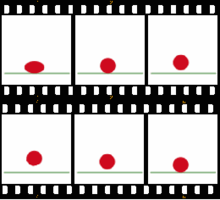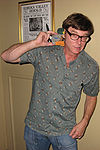Portal:Animation

| Main | Categories and topics | Tasks and projects |
Introduction
Animation is a filmmaking technique by which still images are manipulated to create moving images. In traditional animation, images are drawn or painted by hand on transparent celluloid sheets (cels) to be photographed and exhibited on film. Animation has been recognized as an artistic medium, specifically within the entertainment industry. Many animations are computer animations made with computer-generated imagery (CGI). Stop motion animation, in particular claymation, has continued to exist alongside these other forms.
Animation is contrasted with live-action film, although the two do not exist in isolation. Many moviemakers have produced films that are a hybrid of the two. As CGI increasingly approximates photographic imagery, filmmakers can easily composite 3D animations into their film rather than using practical effects for showy visual effects (VFX). (Full article...)
Selected article
Steven Universe is an American animated television series created by Rebecca Sugar for Cartoon Network. It is a coming-of-age story of a young boy, Steven Universe, who lives in the fictional town of Beach City with the Crystal Gems—Pearl, Garnet, and Amethyst —three magical, humanoid aliens. Steven, who is half-Gem, has adventures with his friends and helps the Gems protect the world from their own kind. It premiered on November 4, 2013 as Cartoon Network's first animated solely created by a woman. The themes of the series include love and family. Books, comics and a video game based on the series have also been released. Sugar developed the series while she was a writer and storyboard artist on Adventure Time, and left the show when Cartoon Network greenlit her series for full production. The series is storyboard-driven, meaning that when episodes are being produced the show's storyboard artists are responsible for writing the dialogue and blocking out the action. The series—which has developed a broad fan base—has been critical acclaimed for its design, music, voice acting, characterization, promotion of LGBTQ themes and science fantasy worldbuilding.
Selected image

Did you know (auto-generated) -

- ... that the Pakistani film Shehr e Tabassum was the first animated cyberpunk film to be made by an Urdu development team?
- ... that the animated film The Exigency took thirteen years to make?
- ... that the stylized animation of Teenage Mutant Ninja Turtles: Mutant Mayhem was inspired by rough sketches in school notebooks?
- ... that, for the animated film Us Again, director and writer Zach Parrish considered a video of an elderly couple dancing to be visceral and ideal inspiration?
- ... that Raoul Servais invented a new technique for combining animation and live action for his short film Harpya?
- ... that "Arnold's Christmas", now considered one of the most memorable episodes from the animated series Hey Arnold!, was almost rejected by network executives because it depicted the Vietnam War?
Selected quote
Selected biography
Dan Povenmire (b. 1963) is an American television director, writer, producer, storyboard artist, and actor associated with several animated television series, best known as the co-creator of the Disney animated series Phineas and Ferb in which he also voices the show's villain, Heinz Doofenshmirtz. Povenmire grew up in Mobile, Alabama, where he was a talented art student who spent summers outdoors and making movies. Povenmire attended the University of South Alabama before deciding to pursue a film career and transferring to the University of Southern California School of Cinematic Arts. Povenmire has been a long-time contributor to the animation business, working on several different animated television series such as The Simpsons, Rocko's Modern Life and SpongeBob SquarePants. He was a longtime director on the prime time series Family Guy, where he was nominated for an Annie Award in 2005. He left the series to create Phineas and Ferb with Jeff "Swampy" Marsh.
Selected list
Season two (Book 2: Earth) of Avatar: The Last Airbender, an American animated television series on Nickelodeon, first aired its 20 episodes from March 17, 2006 to December 1, 2006. The season was created and produced by Michael Dante DiMartino and Bryan Konietzko and starred Zach Tyler Eisen, Mae Whitman, Jack DeSena, Jessie Flower, Dante Basco, Dee Bradley Baker, Mako and Grey DeLisle as the main character voices. In this season, the protagonist Aang and his friends Katara and Sokka are on a quest to find an Earthbending teacher which finishes when they recruit Toph Beifong. After finding important information concerning the war with the Fire Nation, Appa ends up kidnapped. Throughout the season's airing, the show received much critical acclaim, with praises such as, "As a flat concept, Avatar: The Last Airbender is nothing special, but in execution, it is head and shoulders above other children's entertainment", and that "as a whole, the look of Avatar is consistently excellent. Between January 23, 2007 and September 11, 2007, Nickelodeon released five DVD sets for the season: four sets containing five episodes each, and a fifth DVD collection of all twenty episodes.
More did you know...
- ...that the 1966 film Alice of Wonderland in Paris reimagined the Lewis Carroll heroine as an American girl who is obsessed with visiting the French capital?
- ...that in the 1960s, Yōji Kuri was regarded as the creator of Japanese animation most known to the West?
- ...that Peter Keefe's 1980s series Voltron "helped prepare the way for other Japanese-style animation in the United States" such as Pokémon and Power Rangers?
Anniversaries for June 3
- Films released
- 1944 - Angel Puss (United States)
- 1961 - Lickety-Splat (United States)
- Television series and specials
- 2006 - Korgoth of Barbaria, an American animated television pilot airs on Adult Swim
Subportals
Related portals
Wikimedia
The following Wikimedia Foundation sister projects provide more on this subject:
-
Commons
Free media repository -
Wikibooks
Free textbooks and manuals -
Wikidata
Free knowledge base -
Wikinews
Free-content news -
Wikiquote
Collection of quotations -
Wikisource
Free-content library -
Wikiversity
Free learning tools -
Wiktionary
Dictionary and thesaurus

























